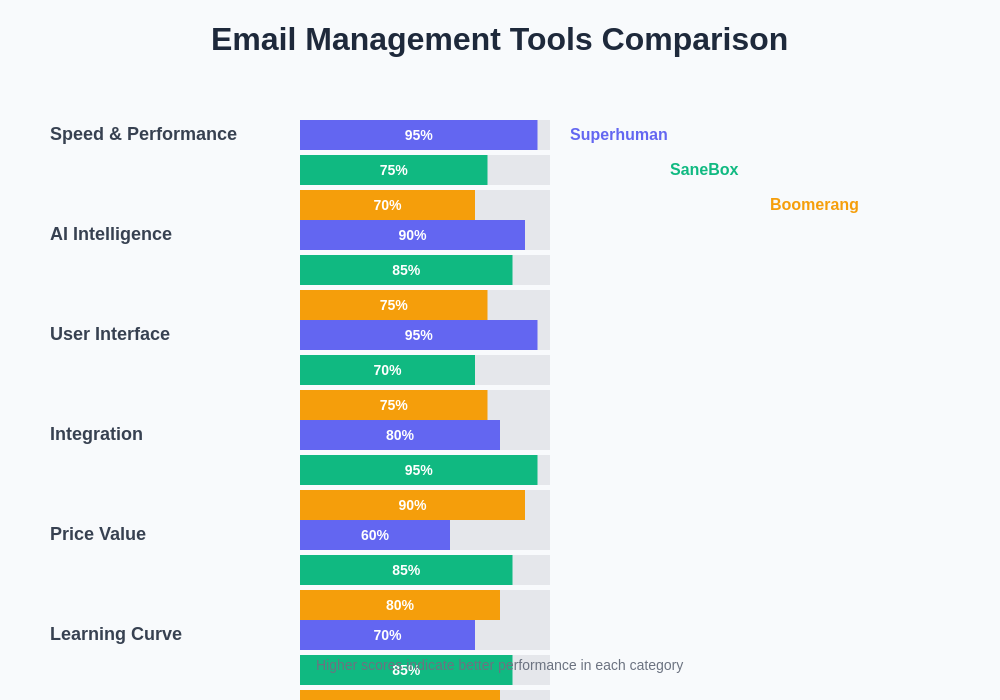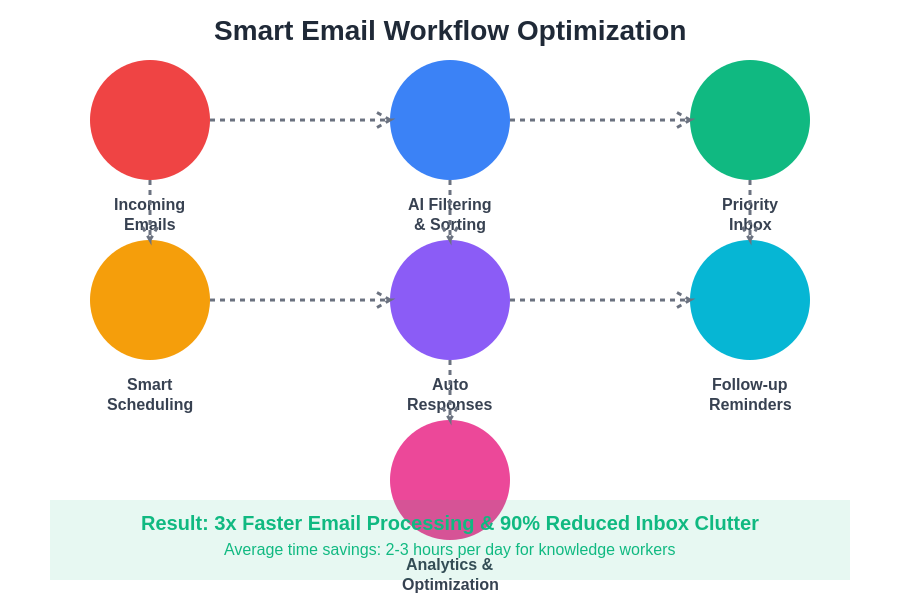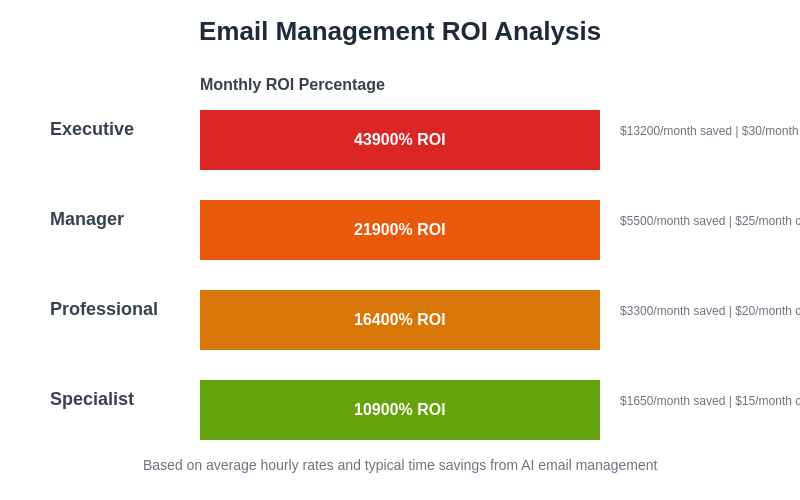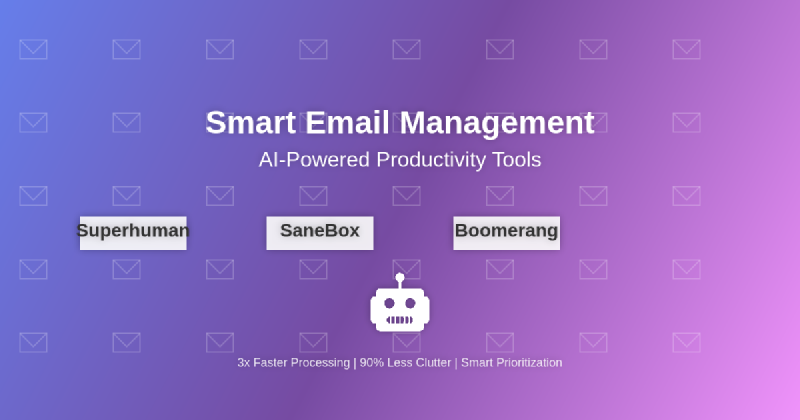The modern professional’s email inbox has evolved from a simple communication tool into a complex battleground where productivity either thrives or dies. With the average knowledge worker receiving over 120 emails daily and spending nearly three hours managing their inbox, the emergence of artificial intelligence-powered email management solutions represents a fundamental shift toward intelligent automation that promises to reclaim countless hours of productive time while dramatically improving communication effectiveness.
Stay updated with the latest AI productivity trends as intelligent email management continues to evolve with breakthrough technologies that are reshaping how professionals handle their digital correspondence. The integration of sophisticated AI algorithms into email platforms has created unprecedented opportunities for streamlining communication workflows, prioritizing critical messages, and automating routine tasks that previously consumed valuable mental bandwidth.
The Email Overwhelm Crisis
The exponential growth of digital communication has created an unprecedented challenge for professionals across all industries, with email volume continuing to surge while traditional inbox management strategies prove increasingly inadequate for handling the complexity and volume of modern correspondence. The average professional now manages multiple email accounts, processes hundreds of messages weekly, and struggles to maintain responsiveness while focusing on core responsibilities that drive business value and career advancement.
Traditional email clients, despite decades of development and refinement, remain fundamentally reactive tools that require manual sorting, prioritization, and response management. This reactive approach creates cognitive overhead that fragments attention, reduces deep work capacity, and generates persistent anxiety about missing critical communications or falling behind on important conversations that require timely responses and thoughtful engagement.
The psychological impact of email overload extends beyond mere productivity concerns, contributing to decision fatigue, increased stress levels, and a persistent sense of being perpetually behind in professional communications. Research indicates that the constant context switching required by traditional email management reduces overall cognitive performance by up to twenty-five percent, making the case for intelligent automation solutions increasingly compelling for professionals seeking to optimize their effectiveness.
Superhuman: Redefining Speed and Intelligence
Superhuman has emerged as the premium solution for professionals who demand maximum efficiency and sophisticated AI-powered features in their email management workflow. Built from the ground up with speed as a core design principle, Superhuman combines lightning-fast performance with intelligent automation features that learn from user behavior to create an increasingly personalized and efficient email experience.
The platform’s signature feature lies in its ability to achieve inbox zero through a combination of keyboard shortcuts, intelligent triage systems, and AI-powered message prioritization that ensures critical communications receive immediate attention while less urgent messages are systematically organized for batch processing. This approach transforms email from a reactive interruption-driven activity into a proactive workflow that aligns with natural productivity rhythms and professional priorities.
Experience advanced AI capabilities with Claude for enhanced productivity workflows that complement intelligent email management systems. Superhuman’s AI engine continuously analyzes communication patterns, sender relationships, and content relevance to surface the most important messages while automatically categorizing routine communications for efficient batch processing during designated email sessions.
The platform’s read receipts and send later functionality provide strategic advantages for professionals who need to optimize communication timing and track engagement with critical messages. These features, combined with Superhuman’s signature reminder system, ensure that important follow-ups never fall through the cracks while maintaining professional communication standards that enhance relationship building and business development efforts.
Superhuman’s integration capabilities extend beyond traditional email functions to encompass calendar coordination, task management, and CRM synchronization that creates a unified productivity ecosystem. This holistic approach eliminates the friction typically associated with switching between multiple applications while ensuring that email-driven actions seamlessly translate into concrete productivity outcomes and measurable business results.
SaneBox: Intelligent Filtering and Prioritization
SaneBox represents the democratization of intelligent email management through its sophisticated filtering algorithms that work across virtually any email platform without requiring a complete workflow overhaul. The platform’s strength lies in its ability to learn from individual email behavior patterns to create increasingly accurate automated sorting that reduces inbox clutter while ensuring important messages receive appropriate attention and timely responses.
The SaneBox algorithm analyzes multiple signals including sender relationships, message content, historical interaction patterns, and temporal factors to create dynamic prioritization that adapts to changing professional needs and communication priorities. This machine learning approach means that the system becomes more effective over time, developing nuanced understanding of individual communication preferences and professional contexts that influence message importance.
The platform’s SaneBlackHole feature provides an elegant solution for managing unwanted communications by automatically unsubscribing users from mailing lists and blocking persistent spam sources. This proactive approach to inbox hygiene eliminates the ongoing cognitive burden of manually managing unwanted communications while ensuring that legitimate messages from new contacts are not inadvertently filtered or delayed.
SaneBox’s reminder and follow-up functionality transforms email into a comprehensive task management system by ensuring that messages requiring action are automatically resurfaced at appropriate intervals. This systematic approach to follow-up management eliminates the mental overhead of tracking pending communications while ensuring that professional relationships are maintained through consistent and timely responses to important messages and requests.
The platform’s digest functionality allows users to batch process less critical communications during designated times rather than being constantly interrupted by notification streams that fragment attention and reduce deep work capacity. This approach aligns with productivity research showing that batch processing of similar tasks significantly improves efficiency while reducing the cognitive switching costs associated with constant email monitoring.

The comparative analysis of leading email management platforms reveals distinct advantages and optimization strategies that align with different professional needs, workflow preferences, and productivity objectives. Understanding these differences enables informed decision-making about which tools will provide maximum value for specific use cases and professional contexts.
Boomerang: Scheduling and Follow-Up Mastery
Boomerang has established itself as the definitive solution for professionals who require sophisticated email scheduling, follow-up automation, and response optimization features that enhance communication effectiveness while reducing manual overhead. The platform’s core strength lies in its ability to transform email timing from a reactive process into a strategic advantage that improves response rates, enhances professional relationships, and optimizes communication impact.
The platform’s send later functionality enables users to compose messages during optimal writing times while ensuring delivery occurs at moments when recipients are most likely to engage positively with the content. This strategic approach to timing leverages research on email engagement patterns to maximize open rates, response rates, and overall communication effectiveness while respecting recipient preferences and time zones.
Boomerang’s follow-up automation eliminates the mental burden of tracking pending communications by automatically returning unanswered messages to the inbox at specified intervals. This systematic approach ensures that important communications receive persistent attention without requiring manual tracking systems that consume cognitive resources and create additional administrative overhead that detracts from core professional responsibilities.
Enhance your research capabilities with Perplexity to gather insights that inform strategic communication timing and content optimization. The platform’s response optimization features include suggested send times based on recipient behavior patterns, optimal subject line recommendations, and content analysis that improves message clarity and engagement potential.
Boomerang’s integration with calendar systems enables sophisticated scheduling workflows that coordinate email communications with meeting requests, project deadlines, and strategic timing considerations. This holistic approach to communication coordination ensures that email timing aligns with broader productivity objectives while maintaining professional communication standards that enhance relationship building and business development efforts.
The platform’s analytics capabilities provide insights into email effectiveness, response patterns, and communication optimization opportunities that inform strategic improvements to professional correspondence. These data-driven insights enable continuous refinement of communication approaches while identifying patterns that enhance overall professional effectiveness and relationship management outcomes.
Comparative Analysis and Selection Criteria
The choice between Superhuman, SaneBox, and Boomerang depends largely on individual productivity preferences, professional requirements, and existing workflow integration needs that vary significantly across different roles, industries, and organizational contexts. Understanding the distinct advantages and limitations of each platform enables informed decision-making that maximizes productivity gains while minimizing workflow disruption during transition periods.
Superhuman excels for professionals who prioritize speed, aesthetic design, and premium features while working primarily within Gmail environments. The platform’s high-performance interface and sophisticated AI capabilities make it ideal for executives, entrepreneurs, and high-volume email users who require maximum efficiency and are willing to invest in premium productivity tools that deliver measurable time savings and enhanced professional capabilities.
SaneBox provides broad compatibility and intelligent filtering that works across multiple email platforms, making it suitable for professionals who require flexibility or work within organizational email systems that limit client choices. The platform’s gradual learning approach and non-disruptive implementation make it ideal for users who want intelligent email management without dramatic workflow changes or steep learning curves that might temporarily reduce productivity.
Boomerang offers specialized scheduling and follow-up capabilities that benefit professionals whose work involves significant coordination, sales activities, or strategic communication timing requirements. The platform’s focus on communication optimization makes it particularly valuable for business development professionals, consultants, and project managers who rely heavily on email for relationship building and coordination activities.

The optimization of email workflows through intelligent tool integration creates compound productivity improvements that extend beyond simple time savings to encompass enhanced professional relationships, reduced stress levels, and improved work-life balance through more effective communication management strategies.
Integration Strategies and Workflow Optimization
Successful implementation of AI-powered email management tools requires thoughtful integration planning that considers existing productivity systems, professional workflows, and organizational requirements that influence tool effectiveness and adoption success. The most successful implementations involve gradual integration approaches that allow for adjustment periods while maintaining productivity levels during transition phases that might otherwise disrupt established communication patterns.
The integration of multiple email management tools can create synergistic effects that amplify individual tool benefits while addressing diverse productivity needs that no single platform fully satisfies. For example, combining SaneBox’s intelligent filtering with Boomerang’s scheduling capabilities can create comprehensive email management workflows that address both inbox organization and strategic communication timing requirements.
Professional teams implementing email management tools should consider coordination strategies that ensure consistent communication standards while accommodating individual productivity preferences and tool choices. This balance between standardization and personalization enables team-wide productivity improvements while respecting individual workflow preferences that influence tool effectiveness and user satisfaction.
The measurement of email management tool effectiveness requires establishing baseline productivity metrics before implementation and tracking improvements in response times, inbox processing efficiency, and overall communication satisfaction. These quantitative assessments provide objective evidence of tool value while identifying optimization opportunities that enhance return on investment and professional effectiveness outcomes.
Advanced Features and Productivity Multipliers
The advanced capabilities of modern email management platforms extend far beyond basic filtering and scheduling to encompass sophisticated analytics, predictive features, and integration ecosystems that transform email from a reactive communication channel into a proactive productivity system that enhances professional effectiveness across multiple dimensions of knowledge work.
Superhuman’s AI-powered insights provide predictive suggestions for message prioritization, optimal response timing, and relationship management strategies that leverage historical communication data to enhance professional relationship outcomes. These intelligence features learn from user behavior patterns to provide increasingly sophisticated recommendations that align with individual professional objectives and communication preferences.
SaneBox’s advanced filtering capabilities include custom rule creation, sender behavior analysis, and adaptive learning systems that continuously refine message categorization accuracy. These sophisticated features enable highly personalized inbox management that adapts to changing professional contexts while maintaining consistent productivity improvements that compound over time through machine learning optimization.
Boomerang’s advanced analytics encompass response rate optimization, send time effectiveness analysis, and communication pattern insights that inform strategic improvements to professional correspondence. These data-driven features enable continuous refinement of communication approaches while identifying successful patterns that can be systematically replicated for enhanced professional effectiveness.
The integration of email management tools with broader productivity ecosystems including task management, calendar coordination, and CRM systems creates comprehensive workflows that eliminate productivity friction while ensuring that email-driven actions translate into concrete outcomes. This holistic approach to productivity optimization leverages email as a central coordination hub for professional activities and relationship management.
Security and Privacy Considerations
The adoption of AI-powered email management tools raises important security and privacy considerations that require careful evaluation of data handling practices, encryption standards, and organizational compliance requirements that vary across industries and regulatory environments. Professional users must balance productivity benefits against potential security risks while ensuring that email management solutions align with organizational policies and professional responsibilities.
Superhuman’s security infrastructure includes enterprise-grade encryption, secure data handling protocols, and privacy features that protect sensitive communications while enabling productivity enhancements. The platform’s commitment to security transparency and regular security audits provides confidence for professionals handling confidential information while leveraging advanced email management capabilities.
SaneBox’s privacy-focused approach includes local processing options, minimal data retention policies, and transparent data usage practices that prioritize user privacy while delivering effective email management automation. The platform’s ability to work across multiple email providers while maintaining consistent security standards makes it suitable for professionals with diverse security requirements and organizational constraints.
Boomerang’s security features encompass encrypted communications, secure scheduling infrastructure, and compliance with industry security standards that protect professional communications while enabling advanced productivity features. The platform’s integration with major email providers leverages existing security frameworks while adding functionality that enhances rather than compromises communication security.
The evaluation of email management tool security should include assessment of data sovereignty, encryption protocols, access controls, and incident response capabilities that protect professional communications while enabling productivity improvements. These security considerations become increasingly important as email management tools gain access to comprehensive communication histories and sensitive professional information.
Return on Investment and Productivity Metrics
The quantification of email management tool benefits requires sophisticated measurement approaches that capture both direct time savings and indirect productivity improvements including reduced stress, enhanced focus capacity, and improved professional relationship outcomes that contribute to long-term career advancement and business success.
Direct productivity measurements include inbox processing time reduction, response time improvements, and email volume management efficiency that provide quantifiable evidence of tool effectiveness. These metrics typically show productivity improvements ranging from twenty to forty percent for professionals who fully implement AI-powered email management solutions while maintaining or improving communication quality standards.
Indirect benefits encompass reduced decision fatigue, improved work-life balance, and enhanced mental bandwidth availability for strategic thinking and creative work that represents the most valuable professional activities. These qualitative improvements, while harder to measure directly, often provide the greatest long-term value through enhanced professional effectiveness and career advancement opportunities.
The cost-benefit analysis of premium email management tools typically demonstrates positive returns within months of implementation for professionals whose time value exceeds the subscription costs by significant margins. The calculation should include both direct time savings and productivity multiplier effects that enhance overall professional effectiveness across multiple dimensions of knowledge work.

The return on investment analysis reveals compelling evidence that AI-powered email management tools deliver substantial productivity improvements that justify their costs while providing ongoing benefits that compound over time through improved communication effectiveness and professional relationship management.
Future Trends and Technological Evolution
The evolution of AI-powered email management continues accelerating with breakthrough technologies including natural language processing improvements, predictive analytics enhancements, and integration ecosystem expansion that promise even more sophisticated automation and intelligence capabilities for professional communication management.
Machine learning advances are enabling increasingly sophisticated message prioritization, content analysis, and response prediction capabilities that will further reduce manual email management overhead while improving communication effectiveness. These technological improvements suggest that future email management tools will provide even more comprehensive automation while maintaining the human elements that make professional communication effective and relationship-building successful.
The integration of voice recognition, mobile optimization, and cross-platform synchronization capabilities will expand email management tool accessibility while enabling more flexible workflow approaches that adapt to diverse professional contexts and productivity preferences. These technological advances will democratize access to sophisticated email management capabilities while maintaining the effectiveness advantages currently available primarily to premium platform users.
Emerging artificial intelligence capabilities including sentiment analysis, context-aware prioritization, and predictive relationship management will transform email from a reactive communication channel into a proactive professional development tool that enhances relationship building, business development, and career advancement through intelligent communication optimization and strategic timing recommendations.
The continued evolution of email management technology promises to eliminate remaining friction points in professional communication while enabling new levels of productivity, effectiveness, and professional relationship management that will reshape how knowledge workers approach their most critical communication activities and relationship building responsibilities.
Implementation Best Practices and Success Strategies
Successful adoption of AI-powered email management tools requires systematic implementation approaches that balance immediate productivity gains with long-term workflow optimization while minimizing disruption to existing professional relationships and communication standards that influence business outcomes and career advancement opportunities.
The most effective implementation strategies involve gradual feature adoption that allows users to develop proficiency with core capabilities before exploring advanced features that require workflow adjustments or behavioral changes. This progressive approach ensures sustained productivity improvements while avoiding the temporary productivity decreases that can occur during aggressive tool implementation phases.
Professional teams should establish communication standards and coordination protocols that leverage email management tools while maintaining consistent professional presentation and response reliability that clients and colleagues expect. These standards should accommodate individual tool preferences while ensuring team-wide productivity improvements and communication effectiveness enhancements.
The measurement and optimization of email management tool effectiveness requires ongoing assessment of productivity metrics, communication quality, and professional relationship outcomes that provide evidence of tool value while identifying optimization opportunities. This continuous improvement approach ensures maximum return on investment while adapting tools to evolving professional needs and changing communication requirements.
Training and proficiency development in email management tools should focus on habit formation, workflow integration, and advanced feature utilization that maximizes productivity benefits while minimizing the ongoing cognitive overhead required for tool operation. Investment in proper training typically accelerates benefit realization while ensuring sustained productivity improvements that justify tool costs and implementation efforts.
Conclusion: Transforming Professional Communication
The revolution in AI-powered email management represents a fundamental shift from reactive communication handling to proactive productivity optimization that promises to reclaim substantial time while enhancing professional effectiveness across multiple dimensions of knowledge work. The sophisticated capabilities of platforms like Superhuman, SaneBox, and Boomerang demonstrate that intelligent automation can successfully augment human communication skills without sacrificing the personal elements that make professional relationships successful and meaningful.
The selection between these powerful platforms depends on individual productivity needs, professional contexts, and workflow preferences that vary significantly across different roles and industries. However, the evidence overwhelmingly supports the conclusion that some form of AI-powered email management provides substantial productivity benefits for virtually any professional who depends on email for significant portions of their daily communication and coordination activities.
The future of professional communication lies not in choosing between human intelligence and artificial intelligence, but in the strategic integration of both capabilities to create communication workflows that leverage the speed and consistency of automation while preserving the creativity, empathy, and strategic thinking that remain essential for building successful professional relationships and achieving meaningful business outcomes.
Disclaimer
This article is for informational purposes only and does not constitute professional advice. The views expressed are based on current understanding of email management technologies and their applications in professional environments. Readers should evaluate their specific needs, security requirements, and organizational policies when selecting email management tools. The effectiveness of these platforms may vary depending on individual usage patterns, professional contexts, and existing productivity systems.
